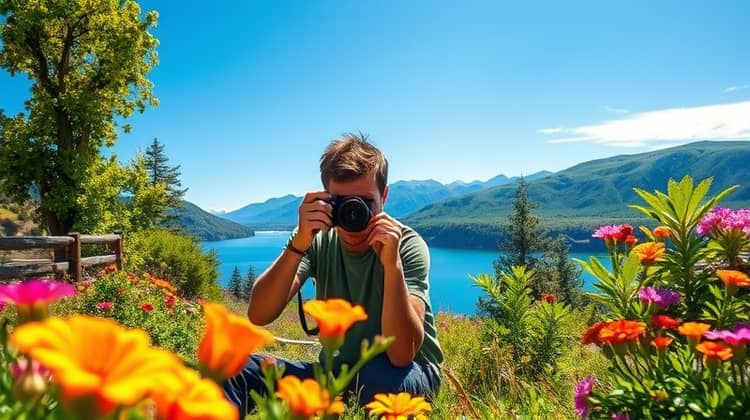Outdoor photography is a captivating pursuit that allows individuals to connect with nature while honing their artistic skills. By venturing outside with a camera in hand, you capture the world’s beauty through your unique perspective. From breathtaking landscapes to intimate wildlife portraits, outdoor photography encompasses a range of subjects that inspire and challenge photographers of all levels.
As we embark on this exploration of outdoor photography, it's essential to understand the key elements that contribute to successful images. Various factors come into play, including technique, equipment, and a keen understanding of outdoor environments. Whether one is a novice or an experienced shooter, refining these elements can significantly enhance the quality of one’s photographs.
In this blog post, we will delve into the appeal of outdoor photography, discuss essential gear, explore capturing techniques, and emphasize the importance of light and composition. By the end, you will feel equipped to venture out and capture nature's beauty through your lens.
The Appeal of Outdoor Photography

There is something inherently enchanting about being outdoors. The fresh air, the sound of rustling leaves, and the sight of vibrant colors create an immersive experience that captures the imagination. Outdoor photography allows individuals to embrace this beauty and showcase it through their artistic vision.
Moreover, outdoor photography encourages exploration, whether that means hiking in remote areas or discovering hidden gems in your local environment. This sense of adventure fosters not only creativity but also a deeper appreciation for the world around us.
Finally, the act of capturing nature can serve as a form of mindfulness and reflection. It provides an opportunity to pause, observe, and connect with one’s surroundings, promoting mental well-being and inspiring a sense of gratitude.
Essential Gear for Outdoor Photography

While passion and creativity are paramount in outdoor photography, having the right gear can greatly enhance your ability to capture compelling images. A sturdy camera is the first necessity; options range from DSLRs to mirrorless systems or even high-quality compact cameras, depending on your preference and level of expertise.
In addition to the camera, a lens with a versatile focal range enables you to capture diverse subjects, whether expansive landscapes or distant wildlife. Other essential items include a tripod for stability and a weather-resistant bag to protect your gear from the elements.
- Camera (DSLR, mirrorless, or compact)
- Versatile lens
- Tripod
- Weather-resistant bag
- Extra batteries and memory cards
- Filters (polarizing or ND)
Techniques for Capturing the Outdoors

When it comes to outdoor photography, mastering specific techniques is key to elevating your results. Understanding how to effectively use your equipment will allow you to capture the essence of your surroundings.
- Use the rule of thirds to create balanced compositions.
- Experiment with different perspectives and angles for dynamic shots.
- Look for leading lines to guide the viewer's eye through the image.
- Employ depth of field to isolate subjects or show the context of a scene.
- Utilize HDR techniques for scenes with high contrast.
Improving your technique will take practice and patience, but over time, you'll see considerable growth in your photographic skills. Each outing will present opportunities to apply what you've learned and to experiment with new methods.
Understanding Natural Light

Natural light is one of the most crucial elements in outdoor photography. Learning to harness it effectively can drastically change your results, transforming ordinary scenes into extraordinary images.
- Use the golden hour for soft, flattering light.
- Avoid shooting in harsh midday sun unless in the shade.
- Look for contrasting light and shadow to add depth.
- Know how to use reflectors or diffusers to control light.
- Be aware of weather changes and how they affect light.
Composition Tips for Outdoor Photography

Composition is a critical aspect of photography that can make or break your image. By applying a few key principles, you can create visually stunning photographs.
- Use leading lines to guide the viewer's eye.
- Incorporate natural frames, such as trees or rocks, to add depth.
- Pay attention to the foreground, middle ground, and background.
- Experiment with symmetry and patterns found in nature.
Settings for Outdoor Photography

Setting your camera correctly is essential for achieving the desired results in outdoor photography. Each shooting scenario may require adjustments to your settings.
- Use a low ISO to minimize noise in bright conditions.
- Adjust your aperture based on the desired depth of field.
- Set the shutter speed appropriately to freeze or blur motion.
- Utilize exposure compensation when dealing with backlighting.
Safety and Ethical Considerations

When pursuing outdoor photography, it’s important to prioritize safety and follow ethical guidelines. Respect for nature ensures that we can continue enjoying these natural environments for years to come.
- Stay informed about the area you are exploring.
- Follow Leave No Trace principles to protect wildlife and habitats.
- Be mindful of weather conditions and your personal limits.
- Never disturb wildlife for the sake of a photograph.
By practicing ethical photography, we can safeguard our natural resources while sharing their beauty with others. Always strive to leave a location as you found it, if not better, and educate others on the importance of conservation.
Embracing safety can make your photography endeavors both enjoyable and responsible. Don't rush, plan adequately, and engage with fellow photographers to learn from their experiences.
Editing Your Outdoor Photos

Once you’ve captured your outdoor images, the next step is editing. Post-processing helps to enhance your photos and bring your vision to life.
- Use software like Adobe Lightroom or Photoshop for edits.
- Adjust exposure, contrast, and color balance for improved quality.
- Crop images thoughtfully to enhance composition.
- Consider adding subtle filters for mood adjustments.
Finding Your Style in Outdoor Photography

Developing a personal style in outdoor photography can set your work apart and add a unique touch to your portfolio.
- Experiment with different photographic genres and techniques.
- Identify subjects that resonate with you and reflect your perspective.
- Study work from photographers you admire for inspiration and insight.
Conclusion

In conclusion, outdoor photography offers a boundless world of creativity, adventure, and appreciation for nature. With the right gear, techniques, and ethical considerations, photographers can capture the richness of the outdoors.
As you venture out with your camera, remember to embrace the beauty surrounding you, practicing patience and curiosity. Each click of the shutter is an opportunity to capture a moment that tells a story.
By continually exploring and honing your skills, you can document the natural world in a way that reflects your personal journey and artistic vision.














